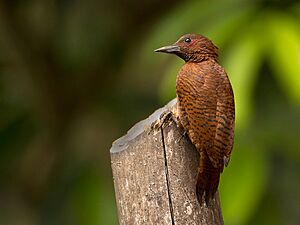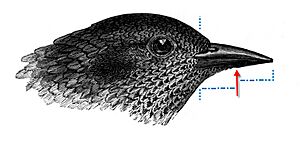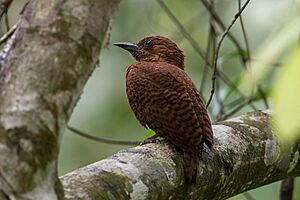Rufous woodpecker facts for kids
Quick facts for kids Rufous woodpecker |
|
|---|---|
 |
|
| Male rufous woodpecker in the Western Ghats | |
| Conservation status | |
| Scientific classification | |
| Genus: |
Micropternus
|
| Species: |
brachyurus
|
| Synonyms | |
|
|
The rufous woodpecker (Micropternus brachyurus) is a medium-sized brown woodpecker. It lives in parts of South and Southeast Asia. This bird has a short bill. It often looks for food in pairs. They mostly eat small insects like ants and termites. You can find them in different types of forests. These include scrub, evergreen, and deciduous forests. A cool fact about them is where they build their nests. They make their homes inside the carton nests of tree-dwelling ants. These ants belong to the genus Crematogaster. For a while, scientists thought this woodpecker was related to a South American bird. But studies showed they just look similar. This is called evolutionary convergence. Now, scientists know it belongs to its own special group, Micropternus.
Contents
How Scientists Classify the Rufous Woodpecker
Scientists group living things based on their features. This is called taxonomy. The rufous woodpecker was once placed in a group called Celeus. These birds live in South America. The rufous woodpecker looked a lot like them. But it lives very far away. This made scientists wonder if they were truly related.
In 2006, scientists studied the bird's DNA. They found that the rufous woodpecker is not closely related to Celeus. Instead, it is more like the Meiglyptes group. So, it was given its own unique group. This group is called Micropternus. It is a monotypic genus. This means it is the only species in its group.
Edward Blyth first created the Micropternus group. He noticed this woodpecker had a short first toe. Its claw was also smaller. Other features include a short bill. The bill does not have a ridge on its nose. Its nostrils are round. The outer tail feathers are short. They are about the same length as the feathers covering the tail.
Across its wide home range, rufous woodpeckers can look a bit different. Their feathers and size can vary. Scientists have named about ten different types, called subspecies. The main type, called the nominate population, is from Java.
- M. b. brachyurus (Vieillot, 1818) – Found in Java.
- M. b. humei Kloss, 1918 – Lives along the western Himalayas. It has a streaky throat. Its head is greyish and face is pale.
- M. b. jerdonii (Malherbe, 1849) – Found in peninsular India and Sri Lanka.
- M. b. phaioceps (Blyth, 1845) – Lives in the eastern Himalayas. This includes central Nepal to Myanmar, Yunnan, and southern Thailand.
- M. b. fokiensis (Swinhoe, 1863) – Found in southeast China and northern Vietnam. It has a sooty (dark) belly.
- M. b. holroydi Swinhoe, 1870 – Lives in Hainan.
- M. b. williamsoni Kloss, 1918 – Found in southern Thailand.
- M. b. annamensis Delacour & Jabouille, 1924 – Lives in Laos, Cambodia, and southern Vietnam.
- M. b. badius (Raffles, 1822) – Found in the Malay Peninsula down to Sumatra.
- M. b. badiosus (Bonaparte, 1850) – Lives in Borneo and the north Natuna Islands. It has a very dark tail.
|
||||||||||||||||||||||||||||||||||||||||||||||||||||||||||||
| Relationship to other genera. |
What the Rufous Woodpecker Looks Like
The rufous woodpecker is about 25 centimeters (10 inches) long. It is mostly dark brown. Its wing and tail feathers have dark bands. This makes them look like they have black stripes. The head often looks lighter in color. The feathers on its belly are a darker shade.
Its bill is short and black. It curves slightly downwards. The bill is narrow near the nostrils. The tail is short and reddish-brown. It has thin black bars. However, one type, badiosus, has a dark tail with thin reddish bars. The edges of the feathers are pale in some subspecies.
The feathers on its neck, ears, and face are plain. Male woodpeckers have red-tipped feathers under their eyes. These red tips can form a patch on their cheeks. Females and young birds do not have these red feather tips. They also have a weak crest of feathers on their head. This crest can be raised. Young birds may have streaks on their throat. Some subspecies also have streaked throat feathers.
In nature, these birds can look dirty. They might even smell like ant secretions. This is because they spend a lot of time around ants. Crematogaster ants spray a fluid at anything that bothers them.
Behavior and Life Cycle
Rufous woodpeckers usually search for food in pairs. They look for ant nests on trees. They also check fallen logs, dung piles, and ant or termite mounds. They are known to eat ants from the Crematogaster and Oecophylla groups. Besides insects, they also drink nectar from flowers. They like flowers from Bombax and Erythrina trees. They also drink sap from banana plants.
Their most common call is a sharp, nasal sound. It sounds like keenk-keenk-keenk. They also make other sounds. These include a long wicka and a series of wick-wick notes. They have a special drumming sound too. It starts fast and then slows down. They drum all year. But they do it more often in winter in southern India. In Nepal, it peaks around March to April.
Sometimes, two birds will face each other and sway their heads. Their bills are held high and tails spread out. Scientists are not sure why they do this.
Nesting and Young
The breeding season is from February to June. This is before the monsoon rains. The rufous woodpecker is famous for its unique nest. It builds its nest inside the nests of acrobat ants (Crematogaster). Both the male and female woodpeckers help dig out the nest. Their feathers can get covered in a dark, sticky fluid. This fluid smells bad. Dead ants are often stuck to their feathers, especially when they are nesting.
They lay two white eggs. The eggs are dull, thin-shelled, and see-through. The eggs hatch in 12 to 14 days. Both parents feed the young birds in the nest.
Habitat and Conservation
The rufous woodpecker lives in many different places. In Malaysia, they can even live in areas where forests have been replaced by palm oil farms. They mostly live in flat areas and lower hills. They are usually found below 3000 meters (about 9800 feet). This bird is not considered in danger. It is listed as "Least Concern" on the IUCN Red List.




